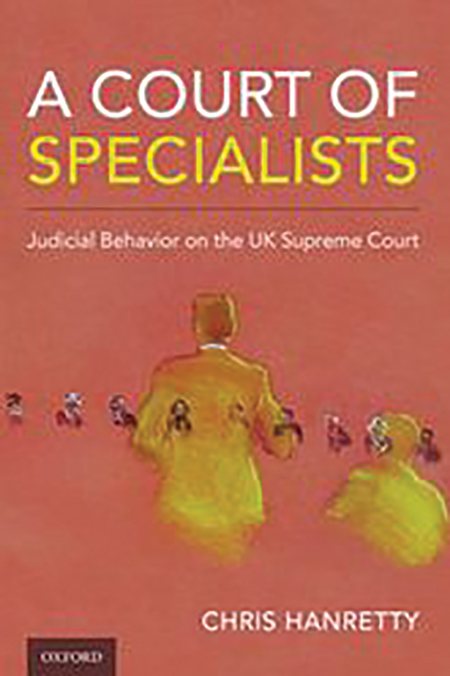
Author: Chris Hanretty
Publisher: Oxford University Press
ISBN: 9780197509234
Price: £64
This is an intriguing study of the legal and non-legal influences that affect decision-making in the UK Supreme Court. It is the first detailed work of its kind, a solitary pendant to the myriad of comparable studies relating to the US Supreme Court and to the few that focus on Canada’s Supreme Court or Australia’s High Court.
Being heavily reliant on quantitative social science methodologies, the book is not always an easy read. For someone like myself, and probably the vast majority of lawyers, it requires really hard thinking to understand concepts such as ‘regression coefficient’ and ‘degrees of freedom parameter’. Some of the statistical notation is especially daunting. But, while the author urges readers not to ‘disattend’ to his chapter on ‘Key Concepts’, I think the thrust of his analyses can still be appreciated without too heavily immersing oneself in the methods employed.
The ‘judicial behavior’ examined (the book prefers US spellings, since it was published there) relates to seven issues: how the Supreme Court grants permission to appeal, how it determines how many Justices should hear an appeal, how it chooses which Justices should sit in the appeal and who should write a judgment, the process of dissenting, whether patterns of dissent can identify ‘left-leaning’ and ‘right-leaning’ Justices and, finally, which categories of appellants tend to win their appeals.
Reassuringly for lawyers, the author’s conclusions largely chime with less numerical assessments previously made by legal academics (Hanretty is primarily a political scientist). Applications for permission to appeal are more likely to be successful if the case is an ‘important’ one, if it involves public law and if in the court below the judges were divided. Hanretty measures importance partly by counting how often the decision appealed against was reported in generalist law reports: this is somewhat odd, given the role that digital reports now play in lawyers’ lives. An extra-legal influence, he claims, is that if the government applies for permission to appeal it is much more likely to obtain permission than other applicants.
The same legal factors, along with the presence of a human rights claim, were found to influence whether appeal panels should be larger than five, whereas the main factor determining which Justices should sit, and who should write judgments, was ‘specialisation’. Indeed the book’s central contention is that the Supreme Court, more than its predecessor and apex courts in other common law countries, is essentially a collection of experts in different areas of law, although he labels Scottish and Northern Irish law as specialisms too, even though the substantive law is often identical to that in England and Wales and a judge from a devolved region may also be a national expert in a legal field, such as Lord Kerr in human rights law.
Hanretty could not identify many factors—legal or otherwise—affecting a Justice’s propensity to dissent. He confirms that dissents are more common when there are more than five Justices hearing an appeal and less common when the appeals are from Scotland. He supports the view that Justices can be ‘arrayed on a dimension running from left to right’. His use of such terms is perhaps questionable. I think liberal / conservative or, better still, activist / restrained, are better polarities in this context. Rachel Cahill-O’Callaghan, in another recent study, perceptibly refers to the values of the Justices. All judges are aware of the importance of not being politically ideological in their legal reasoning, but they definitely differ as to when they think it is appropriate for them to develop the law. Hanretty illustrates this well in his discussion of the Nicklinson case on assisted suicide ([2014] UKSC 38). The striking image on the book’s cover was inspired by that case.
On the final issue examined—success rates in appeals—Hanretty finds that the biggest predictor is whether there was a split decision in the court below. That too seems unsurprising.
In short, the book is a brave attempt to provide statistical evidence showing that Supreme Court judgments are much more influenced by legal factors than by other factors. At the same time Hanretty reinforces the view that our top judges are political in so far as they sometimes allow their view of what is fair and just in society to influence their judgments. He is honest enough to admit the limitations of his study (eg it ignores the gender issue) and he concedes that a previous position he espoused was incorrect. The book has a number of minor legal and typographical errors, but it is a thoroughly rigorous piece of research that deserves a wide readership.
Reviewer: Brice Dickson is Professor Emeritus at Queen’s University Belfast.












